Cervical Lordosis
Table of Contents
What Is Cervical Lordosis?
- Cervical Lordosis is the natural curve of the cervical spine in the neck. It is slightly curved C-shape allows movement of the spine’s first 7 vertebrae, which are located in the neck. With an offset curve, problems with the related nerves and neck muscle tissue can develop and produce physical discomfort or pain.
- The inward curve of a healthy cervical spine sits in a position to support the head movement and protect the tendons, ligaments, muscles, bones, and nerves of this neck region.
- Cervical lordosis is when your spine in the neck does not curve as it normally should. This can mean: There is extravagant of a curve. The cervical spine curve is running in the opposite direction, also called reverse cervical lordosis.
Anatomy of cervical spine:
Vertebrae
The seven vertebrae in the cervical spine range from the bottom of the skull to the top of the shoulder. The smallest within the entire spinal column, these vertebrae provide support for the head and protect the spinal cord, give the neck structure, and support head and neck movements.
Atlas (C1) and Axis(C2)
- The upper cervical spine is unlike some other part of the vertebral column. The atlas and axis are referred to as atypical vertebrae because they have features that set them apart from the rest of the cervical spine.
- The C1 and C2 are part of the spine’s craniovertebral junction (CVJ)—this is where the base of your brain becomes part of your spinal column.
- The atlas(C1) and axis(C2) are make up the most mobile section of your whole spine. Working together, these vertebrae are responsible for approximately 50% of flexion and 50% of rotation; the nodding, bending, and rotation movements of the head. C1 and C2 are also help support your head movement.
C3-C7 Vertebrae
- Cervical vertebrae C3-C7 are similar in shape and function and are called typical vertebra.
- The vertebral bodies are round shapes. If you compare the thoracic and lumbar vertebrae to the cervical, you will see the C3-C7 bones are smaller.
- C7 has a longer spinous process than another vertebrae. If you place your hand at the back of your neck area, you can feel this bone protruding to the skin.
Intervertebral Discs (IVD)
- The cervical spine has six IVD. They are found between all level starting below axis. These Intervertebral discs are strong flexible tissues of fibrocartilage made from two part:
- Annulus fibrosus: the outer portion of the disc, this protective like-tire layer is more strong.
- Nucleus pulposus: inner portion is like- gel structure surrounded by the annulus fibrosis.
Cervical Spine and Supporting Structures
- Ligaments, tendons, and muscles are soft but strong tissues that help support the neck as well as the whole spinal column by limiting excessive movement.
Neck Muscles
Anterior Neck Muscles
- This muscles are found on the front of the neck area. They play a task in speech, swallowing, breathing, and head movements. There are multiple anterior neck muscles, including:
- Infrahyoids: A group of four muscles that move your larynx up and down.
- Playtsma: Covers part of the upper chest and shoulder, extending to the jaw. Assists with jaw and mouth movements.
- Scalenes: Three muscles that help stabilize cervical vertebrae, move the neck, and move your ribs when you are breathing.
- Sternocleidomastoid muscle: Sternocleidomastoid is one of the largest neck muscles, Sternocleidomastoid begins on the side the ear and stretches down to the collarbone. This muscle helps move your head and extend your neck.
- Subclavius: Keeps your collarbone stable after you move your shoulder and arms.
- Suprahyoids: A group of four muscles that move your hyoid bone , when you chew, speak, and swallow.
Lateral Prevertebral Neck Muscles
- The lateral prevertebral muscles are a geggle of cervical muscles located on side of the neck area. These muscles are responsible for rotating the neck and side-to-side neck movements. They also help stabilize the cervical vertebral column. They include:
- Longus capitis and longus colli: Two muscles that help turn the head from side to side, and turn and bend the cervical spine.
- Rectus capitis anterior & rectus captitis lateralis: Two muscles that control head movements.
Posterior Neck Muscles:
- This muscles are located at the back of the neck area. They assist stabilize the vertebral column and assist with head movements. They include:
- Splenius capitis and splenius cervicis: Help you flexion, extension, rotation, and tilt your neck.
- Suboccipital muscles: Group of 4 muscles that help extend your head in numerous directions and play a role in small head movements.
- Transversospinalis muscles: Group of five transversospinalis muscles that help the head tilt from side to side and move forward and backward. Transversospinalis muscle are provide stability for the cervical, thoracic, and lumbar spines.
Ligaments:
- Ligaments are strong bands of fibrous, like-rubber tissue.
- In the neck, ligaments help connect the cervical vertebrae together and keep them provide stability and mobility.
- Tendons are fibrous cords of soft tissue that attach neck muscles to bone in the neck and all over the rest of the body.
joint:
- The bones in your neck are connected by facet joints — small joints that have cartilage to support motion between the seven vertebrae in the cervical spine.
- Facet joints work with the neck muscles to produce mobility and flexibility in the neck area to help you move your head in all directions.
Cervical Spine and the Central Nervous System
- The cervical spinal nerves perform these functions including:
- C1, C2, and C3 are vertebrae that provide a motor function to the head and neck, as well as sensation from the highest of your scalp to the sides of your face
- C4 enables you to shrug your shoulders and causes the diaphragm to contract when breathing. The fourth cervical spinal nerve also provides sensation( like hot, or cold.) to your neck, shoulders, and parts of your upper arms
- C5 enables various upper body movements like raising your shoulders and flexing your biceps and enables feeling to the tip of the shoulder
- C6 allows you to move your wrists and flex your biceps muscle and also provides sensation to the thumb side of your forearms and hand
- C7 powers the triceps muscle on the back of your upper arms and transmits sensation(ex hot, cold..) along the back of the arms, and down to the middle finger
- C8 allows you to open and close your hands and gives you the ability to feel the outer side of your hands and forearm
Which are the causes of Cervical Lordosis?
- Postural Changes: A change in the curvature can happen over time with habitual bad posture when standing, frequent weightlifting activity, or abnormal sitting posture.
- Congenital Conditions: There may be a slightly visible change in the cervical spine at birth. This can be due to development within the womb or to trauma to the neck during the birth time, whether by normal delivery or cesarean section.
- Musculoskeletal Conditions: Musculoskeletal conditions affecting the spine can cause a curvature change. This may be seen with scoliosis, kyphosis, and spondylolisthesis.
- Osteoporosis: The bones of the cervical spine can become weak over time and shift, while the conditions of discitis or disc herniation can alter the spinal discs.
- Obesity: :Obesity is a complex disease involving an maximum amount of body fat.
What are the symptoms of cervical lordosis?
- neck pain
- pain that radiates into the shoulder , forearm and fingers.
- tingling or numbness: neck down through the arm and into the fingers.
- stiffness of the neck muscle.
- loss of the sensation
- headache: you might have nausea, pain on one side of your head due to cervical lordosis.
- difficulty maintaining muscle control.
Diagnosis:
- Test: x-ray
- The patient stands to reveal the whole length of the spine when PA (posterior/anterior, or back and front) and Lateral (side) x-rays are taken.
- MRI and CT:
- Magnetic resonance imaging (MRI) is used to terminate the possibility of spinal cord or nerve abnormalities in body.
- Computed tomography scans (CT scans) are used to get a more detailed image of the bones, muscles and affected organs of the lumbar region.
Treatment of Cervical lordosis:
- Initially symptomatic medical treatment with combination of Physiotherapy treatment & exercise correct the posture, in severe surgery is the last prescribed option.
Medical Treatment:
- An-inflammatory medicines can relieve neck pain.
- Over-the-counter pain relievers: Acetaminophen (Tylenol), ibuprofen, (Advil, Motrin IB), naproxen (Aleve)
- Calcium and vitamin D supplements.
Physiotherapy Treatment of Cervical lordosis:
Physiotherapy treatment is also depends upon symptoms and exercise of Neck. Symptomatic pain relieving Electrotherapy modalities are used such as Short wave Diathermy (SWD), Interferential therapy (IFT), Ultrasound therapy, These modalities helps to relieve pain, muscle spasm and tenderness.
- Cervical collars, also known as neck braces or C collars, are used to support your spinal cord and neck.
Cervical Isometric Exercise:
Rotation

- Place the heel of your right hand as opposed to the side of your forehead.
- Attempt to turn your head to the correct while resisting together with your hand.
- Repeat on the other side
Side bend

- Place your right hand over your right ear.
- Attempt to tip your right ear to your right shoulder while resisting with your hands.
- Repeat on the other side.
Extension
- Grasp both hands behind your head, and use a towel sling.
- Attempt to tip your head back to look up at the roof while resisting with your hands.
Seated Chin Tuck
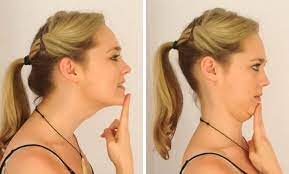
- Sit up straight with your gaze to look straight ahead.
- Place one hand on your chin, and push your head backward as far as you can easily.
- Hold this position for one to 2 seconds.
- Slowly move your neck backward and forwards.
- Do one to two sets of 8 to 10 repetitions.
Seated Chin Nodding
- Sit up straight and place a towel around the back of your neck area.
- Hold on to both ends of the towel.
- Look all the way down, then slowly up. This is parallel to nodding your head up and down.
- Do one to two sets of 8 to 10 repetitions.
Seated Chin Nodding With a Theraband
- Sit up straight and but use a resistance band around the back of your neck area
- Hold both ends of the band while looking up and down. If the band is causing extreme pressure on your neck, place a towel flat against your neck to reduce irritation directly with your skin area.
- Do one to two sets of 8 to 10 repetitions.
- Progress to a thicker resistance band as your stability improves.
Upper Thoracic and Shoulder Extension
- Roll up a thick towel and place it in under your back area.
- Lay down on the towel so that it is similar to your upper thoracic spine.
- This works best if you’re contact a workout bench.
- Lay with your arms out to the sides at 90 degrees and slightly extended.
- Pull your shoulder blades together, hold for 1 to 2 seconds, then relax.
- Do one to two sets of 8 to 10 repetitions.
Shoulder Shrugs:
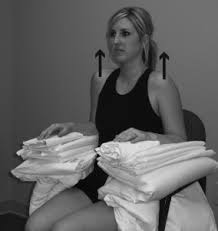
- Stand or sit with arms at the sides and hands straight with fingers pointing down.
- lift both shoulders up while keeping the head and neck still.
- Hold in the upward position for 3 seconds before returning to starting position and repeating 10 times.
Backward Shoulder Retraction:
- In a sitting or standing position, place hands along the hips as one arm and shoulder are moved backward.
- As the arm is bent and the shoulder is back, hold this position for 3 seconds before returning to starting position. Repeat ten times.
Forward Shoulder Retraction:
- This stretch can be done in a standing /sitting position.
- Move one hand to the other shoulder and hold the position for 3 seconds. The arm should be bend at the elbow and the back should be kept straight. Return to starting position and repeat ten times.
Stretching of the cervical region
Flexion /Extension
- Bring your chin to your chest and hold.
- Return to upright, then bring your head back and hold.
- Hold the back of your neck with your hands if you need further support.
Side bending
- Bend your ear to your right shoulder while looking straight ahead hold, then alternate position.
Rotation
- Turn to look over your right shoulder and hold, then switch sides.
- Add mild hand pressure at the chin as tolerated for more stretch.
Scalene
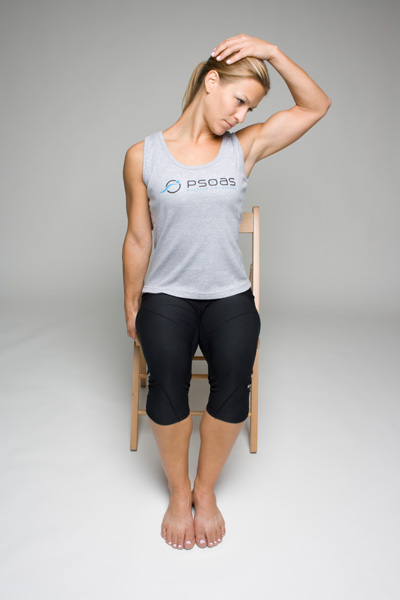
- Sit with your right hand holding the border of the chair.
- Place your left hand above your right collarbone to stabilize.
- Pull chin back, tip ear to left shoulder, turn to look over the left shoulder and hold, and Repeat on the right side.
- Hold each stretch for 30-60 seconds if tolerated for lengthening of scalene muscles; repeat 2-3 times for each muscle.
Upper trapezius
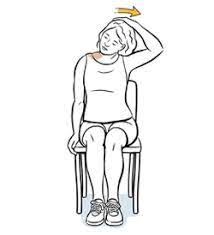
- Sit with the right hand holding border of the chair.
- Move chin towards your chest, tilt your left ear to your left shoulder turn right to look up toward the ceiling. Left hand can be used for over pressure-DON’T PULL and Repeat to the right side
- Hold each stretch for 30-60 seconds if tolerated for lengthening of upper trapezius muscles; repeat 2-3 time each muscle.
Levator Scapulae
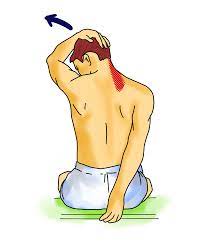
- Sit with the right hand holding border of chair.
- Tip chin towards chest, tip ear to your left shoulder and nose to your left armpit. Left hand can be used for gentle over pressure-DON’T PULL and Alternate the other side.
- Hold each stretch for 30-60 seconds if tolerated for lengthening of levator scapulae muscles; repeat 2-3 time each muscle
Surgical Treatment
- Surgery for cervical lordosis would usually be recommended if the curve of your cervical spine is very pronounced. the curve is causing persistent pain that can’t be controlled with drug. the curve is disrupting your body is other important functions,Severe cervical lordosis may require surgery.
How to prevent cervical lordosis?
- sit correctly – sit upright, ensuring that all of the upper back is supported.
- To maintain a good posture.
- Be consciousness of maintaining an upright neck posture in all your activities.
- Strengthen your neck muscles by exercise.
- Use a chair with good upper back support.

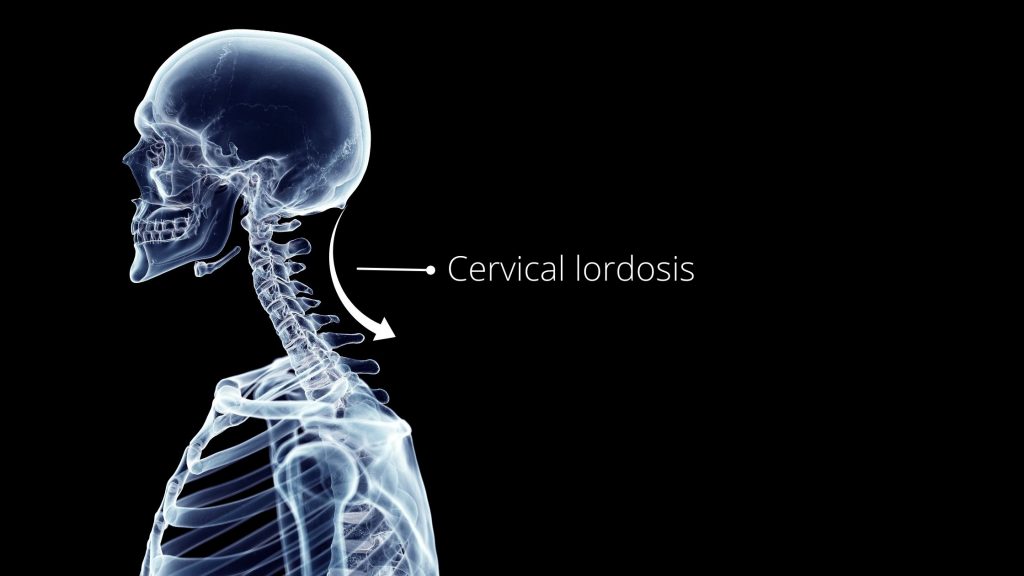
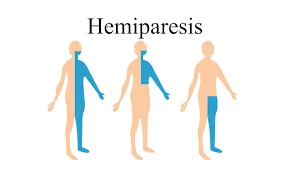
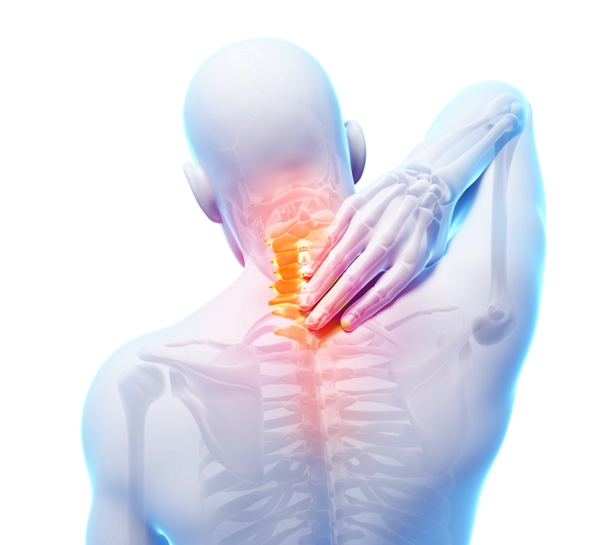
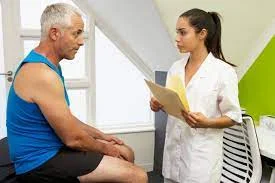
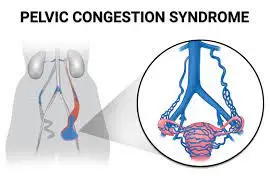
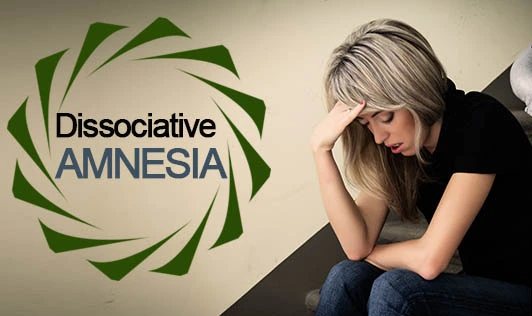
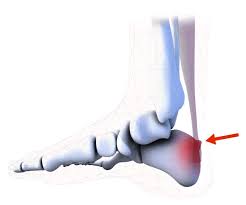
2 Comments